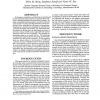Free Online Productivity Tools
i2Speak
i2Symbol
i2OCR
iTex2Img
iWeb2Print
iWeb2Shot
i2Type
iPdf2Split
iPdf2Merge
i2Bopomofo
i2Arabic
i2Style
i2Image
i2PDF
iLatex2Rtf
Sci2ools
NAACL
1994
1994
Phonological Parsing for Bi-directional Letter-to-Sound/Sound-to-Letter Generation
In this paper, we describe a reversibleletter-to-sound/soundto-letter generation system based on an approach which combines a rule-based formalism with data-driven techniques. We adopt a probabilisticparsing strategy to provide a hierarchical lexical analysis of a word, including information such as morphology, stress, syllabification, phonemics and graphemics. Long-distance constraints are propagated by enforcing local constraints throughout the hierarchy. Our training and testing corpora are derived from the high-frequency portion of the Brown Corpus (10,000 words), augmented with markers indicating stress and word morphology. We evaluated our performance based on an unseen test set. The percentage of nonparsable words for letter-to-sound and sound-to-letter generation were 6% and 5% respectively. Of the remaining
Hierarchical Lexical Analysis | Markers Indicating Stress | NAACL 1994 | NAACL 2007 | Rule-based Formalism |
| Added | 02 Nov 2010 |
| Updated | 02 Nov 2010 |
| Type | Conference |
| Year | 1994 |
| Where | NAACL |
| Authors | Helen M. Meng, Stephanie Seneff, Victor Zue |
Comments (0)

